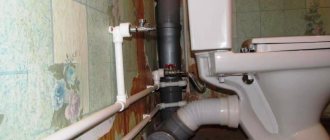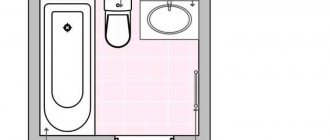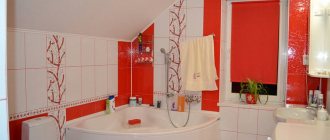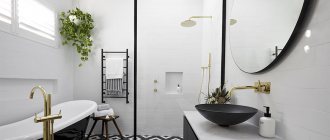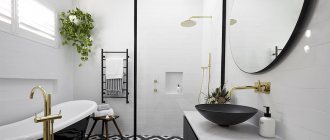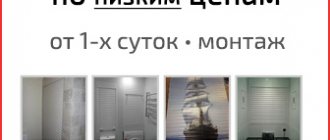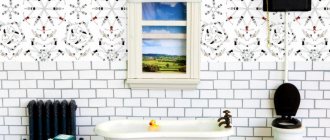When you hear the word “East”, as a rule, associations arise with luxurious apartments, decorated with carpets and curtains. Oriental motifs have become quite popular in design solutions. This applies not only to the design of residential premises, but also to bathrooms. Nowadays, an oriental-style bathroom in an apartment or house is not uncommon.
An oriental-style bathroom can look luxurious or laconic, depending on the chosen direction. In any case, the interior will be unusual and perhaps even a little mysterious
Bathroom in oriental style: variety of design trends
The East unites numerous Asian and African countries: Japan, India, China, Morocco and others. Their religion and culture were reflected in the style of interior design. A common feature is a mysterious aura that arouses interest and a desire to find out the semantic meaning of unique furnishings. Regardless of the geographical location of the country in the East, the basic basis of a bathroom interior in an oriental style is formed according to generally accepted design canons:
- The bathing and washing room occupies a large space of at least 30 m² and high ceilings.
- Functional zones are separated by pointed arches.
Arches divide rooms into functional zones
- A massive font is placed on a podium arranged in the central part of the room.
- The ceiling is decorated with picturesque paintings or decorated with wood and carvings. All kinds of decor with a difficult to recognize storyline are welcome, allowing you to spend hours looking at and guessing about the artist’s ideas.
- For finishing, only natural materials are used - natural stone, tiles with oriental ornaments.
Natural materials are used for finishing
- Ornate patterns, recognizable in every element of the interior, should not reflect the faces of people and animals. The main emphasis of the decor is on ethnic and floral motifs.
- Plumbing is treated as a work of art. It is allowed to install a streamlined sink and mixer made of valuable metal or coated with platinum, gold, or brass.
- The natural color scheme, where bright, warm tones predominate, embodying the sultry climate of the countries of the rising sun, forms the color palette of the interior.
The color palette is dominated by warm tones
Depending on the geographical direction, an oriental-style bathtub has different interpretations that need to be examined separately in detail.
Indian style
The main features of Indian style are a diverse color palette that creates an atmosphere of luxury and comfort. The tile patterns feature traditional colors: gold, turquoise, burgundy and purple-red.
The overall style is complemented by plumbing fixtures with ornaments and prints, a wooden or mosaic-inlaid floor, bright upholstery, finishing and decorative details made of natural stone and wood.
Arabic style vector in bathroom interior
The appearance of the bathhouse in Arab countries delights with its rich decoration, amazingly complex lace carvings, and dazzling sunny colors. To recreate such an interior, it is necessary to use numerous design techniques:
- Construct high ceiling vaults.
- Decorate the walls with mosque silhouettes.
- Large windows should be made with arched and lancet outlines. They must be equipped with filigree embossed metal grilles, delicately bordering the glass with stained glass paintings.
Windows with arched outlines
- A bathtub, chandelier, plumbing fixtures, furniture and other elements of an oriental-style bathroom interior are characterized by rounded silhouettes.
- Expensive materials are used for finishing - forged metal, marble, glazed mosaics, high-quality tiles of non-trivial shapes with a hex or octagonal frame.
- Buildings of complex architectural forms, made of perforated metal or carved wood, are welcome. For example, above the font it is appropriate to install a four-sided stand with graceful supports and a massive upper part, demonstrating the unlimited possibilities of figured wood carving or metal chasing.
- A non-trivial layout of tiles diagonally or laid in a chaotic manner will emphasize the inimitable aesthetics of the Arabic style.
Spectacular Arabic style tiles
- The impressive color scheme is a combination of gold, bronze, and sand tones, symbolizing the climatic features of Arab countries.
- The minimal furnishing of the bathroom is explained by the desire of the designers not to distract the attention of others from the unsurpassed and incredibly complex cladding of a huge space with multi-million dollar scattering of ceramic mosaics.
- A sophisticated decoration would be the use of coins when decorating a room for ablutions. They can be used to frame mirrors, create an edge around a bathtub, or lay out various compositions on the floor or walls. Such extravagance is inherent in the oriental style, which is associated with the fulfillment of any desires with the help of Aladdin’s magic lamp or through the unlimited wealth of Arab sheikhs.
Fairytale bathroom interior in oriental style
It is advisable to create a fabulous atmosphere in the bathroom, because it is here that you can temporarily forget about the harsh reality, achieve harmony of soul and body, which has been promoted by Eastern wisdom for many centuries.
Luxury in the Middle East
The demand for national notes in the interior is growing day by day. Those who love to explore the multifaceted world will love a bathroom with fascinating motifs from the East.
Turkish flavor
It is hardly possible to set up a real hammam instead of a traditional bathroom, but taking the basic ideas for a Turkish-style bath is quite acceptable. A striking feature of this interior is small mosaic tiles. It is often presented in a blue-blue hue, although the design can also be found with other backgrounds.
For finishing materials and textile decor choose:
- light green, emerald and other shades of green;
- yellow and golden;
- blue and blue;
- shades of brown from sand to dark chocolate;
- less common are burgundy, purple, and red-brown.
Attention! All colors are extremely saturated; muted shades are practically not used in a bathroom with Turkish design.
Characteristic features of Turkish style in the bathroom:
- Surface finishing is carried out with fine mosaics.
- Standard sized tiles will help reduce the labor intensity of the process. To decorate a bathroom in an oriental style, choose products with a paisley pattern (another name is Turkish cucumber) or damask patterns. Images of animals and people in the interior of a bathroom with oriental style are not allowed.
- To prevent your eyes from being dazzled by the abundance of ornamentation, which is considered a distinctive feature of the oriental style, the decoration of the walls in the bathroom can be combined with plain surfaces. Moisture-resistant wooden panels, painting or decorative putty in an oriental style will come in handy.
- The bathroom interior contains copper plumbing elements. This could be faucets, a sink, or even a shower head.
- The furniture in the bathroom, where the oriental spirit hovers, is represented by low cabinets, you can find a painted table and an ottoman.
When decorating the interior, they try to avoid straight lines; all outlines are smooth. A striking example of an oriental-style bathroom design is shown in the photo:
Mysterious Egypt
The bathroom, where Egyptian motifs are actively involved in the design, looks no less attractive. The rich luxury of an oriental-style interior requires a spacious room, so small spaces are not suitable for decoration.
The color palette of the bathroom is dominated by yellow. Sand is combined with a golden hue; beige, chocolate and other shades of brown are also present as a complement.
The walls of an Egyptian-style bathroom are decorated with ceramic tiles or textured plaster in appropriate colors.
Comment! Complex architectural forms are welcomed in the oriental interior. These can be columns, arches and other design delights.
Furniture for the Egyptian bathroom is chosen from expensive wood with a slightly pretentious decor. Gilded handles and legs in the shape of animal paws are the most current design solutions. Gilding is also present in the frames of the mirrors.
Beige or sand-colored plumbing fixtures will organically fit into the oriental style with an Egyptian twist; there are also golden-colored elements here. The bath can be replaced with a jacuzzi.
To express the oriental style in the bathroom interior, I actively use lighting fixtures. Usually these are massive lamps of original shapes, made of wood or perforated brass. Choose models that provide soft and subdued bathroom lighting.
The magic of Morocco
A Moroccan-style bathroom is the embodiment of mysterious beauty, brilliance and luxury. In terms of decorativeness, it is ahead of all other oriental interiors, while maintaining elegance and perfection of taste.
The design is based on a rich color palette. The atmosphere of the bathroom is filled with the following tones:
- a wide palette of yellow (from sand to ocher);
- deep shades of red;
- brown and orange;
- ultramarine, cobalt and turquoise.
There is another approach to creating a Moroccan style in the bathroom, when the interior is represented by a combination of white and black.
One of the features of oriental design with a Moroccan flavor is exquisite architectural elements in the form of pointed arches or niches. The elegant shape of arches is used to decorate window and door openings in the bathroom; niches are intended for installing shelves or mirrors. An example of an Arabic-style bathroom in the photo:
Tadelakt mineral plaster can create the effect of marble walls in an oriental interior. Wall cladding with ceramic tiles of miniature sizes is welcome; the side of the product should not exceed 6 cm. The fabulous beauty of a Moroccan-style bathtub is revealed due to the presence of amazing patterns, it can be Arabic script, geometric shapes, stars or floral patterns.
Comment! Not only bathroom walls are decorated with mosaics. It is customary to decorate the countertop under the sink in oriental style. The pattern can smoothly flow from the vertical plane to the floor surface.
Characteristic features of oriental style in a bathroom with a Moroccan twist:
- Bronze or copper faucets.
- Intricate faucet shape.
- Dark stone plumbing.
- Low furniture of simple outlines; if there are handles, choose solid wooden parts.
- Brass lamps, where the decoration is made of colored glass inserts, metal carvings or embossing.
Photos will help you appreciate the fabulous atmosphere of a Moroccan-style bathroom:
Bath in oriental style according to Japanese canons
Japan and China have always had a contradictory view of the art of home improvement with philosophical overtones. If you give preference to the Japanese direction, the design of a bathtub in an oriental style will reflect an ascetic environment with a lack of decor, sparse decoration, furniture, and a restrained range of colors. To design it you will need minimal components:
- The walls are finished with wooden panels with a natural color without decorative elements.
- The palette is formed from natural neutral tones: white, wood, blue, grass.
Japanese-style bathroom walls are finished with wood panels
- Be sure to fill the room with light as much as possible. The construction of a window located opposite the wash area with an enormous mirror is welcome.
- The Japanese direction denies all excess and pretentiousness. When choosing a hot tub, you can easily limit yourself to traditional cast iron with a snow-white color. The Japanese have a tradition of taking unbearably hot baths twice a day. For this purpose, a small oval-shaped ofuro font is used. Previously, it was made exclusively from wood and visually resembled a voluminous barrel. Today, ofuros are made from different materials with a built-in water heating system. Some models are equipped with lids to maintain high water temperatures. You need to immerse yourself in this unique font with a clean body. Therefore, before diving into it, you must take a shower.
Oval-shaped font-ofuro
- To ensure that all the things and hygiene items necessary for taking a bath are at hand, it is important to use a habuzai woven from bamboo (a portable stand in the form of a low coffee table).
- The aesthetic landmark of the oriental style will be sakura branches placed in long transparent vessels.
Sakura branches will give the interior an oriental flavor
For the Japanese, spiritual fulfillment is especially valuable and the arrangement of a bathing room is very insignificant. Therefore, the interior of the bathhouse is impressed by the simplicity and laconicism of the decor, the convenience of unobtrusive storage systems and a comfortable environment for philosophical reflection.
Turkish interior. What is interesting in a Turkish house?
Each of us has our own view on the quantity and quality of furniture in our home. For some, a folding bed is enough, but for others, all the items in a furniture store will not be enough. How are things going with furniture in Turkey? Let's figure it out.
Many people believe that Turks are very picky about the decor and furniture in their home. Women in Turkey have been organizing their lives for decades. No one in the house except a woman has the right to move, rearrange or, God forbid, throw anything away. In addition, Turkish women devote their entire lives to the home, creating comfort and supporting the family hearth. Their home is their fortress.
The main attribute of every Turkish home, no matter what cities in Turkey you visit , is the carpet. In Turkey they are laid everywhere. However, a carpet in Turkey is not only a sign of wealth and aesthetic taste. First of all, it is a heat keeper in their homes. In winter, all houses in Turkey are covered with winter carpets with a thickness of 1.5 centimeters. In order to retain heat, they cover all areas of the floor.
The carpets here are real - wool. By the way, in Turkey it is also customary to stuff pillows with six sheep. But such pillows require special care, since wool tends to get into shreds.
It is considered quite normal in Turkey to take off your shoes and leave them outside the door. And if we don’t have these shoes in a matter of seconds, then in Turkey no one will touch them, since this is not customary there. Other orders.
"Turkish House" is a model of home furnishings in Turkey. Turks prefer functional and at the same time decorative furniture. Furniture made and decorated by hand is highly valued.
In the center of the room, as a rule, there is an ottoman - a comfortable sofa without a back. It is low and soft. For comfort, the sofas are equipped with mattresses and a sea of pillows. Upholstered furniture in a Turkish home is very high quality and elegant. She has long won love all over the world.
The presence of a handmade chest in a Turkish home is also not new. In such chests, both once and now, clothes, food, and various household items are stored. Many of these chests are locked. They are made without the use of nails, from cypress, which has a beneficial effect on the smell of the things stored in them.
Basically, the living environment in Turkey is classical. Tables, chairs, sofas, armchairs, cabinets, coffee tables and chests of drawers - all this is present in Turkish homes.
Convenience, external beauty and quality are the main criteria for the attributes of furniture in Turkey.
Note:
One of the types of furniture that can decorate an interior is chests of drawers. Stylized in an antique style (for example, in the lush Renaissance style), they will favorably emphasize the design of the room and attract the eye.
Category: Interior | Views: 7926
| Date: 2014-03-03 | Tags: interior
Chinese style bathroom design
Against the background of a modest bathroom with Japanese filling, a room with the same purpose, but contrasting design in the Chinese style genre looks colorful:
- The flooring is done using colorfully decorated porcelain stoneware slabs, which can depict flowering plants, pastoral scenes, or ornaments that recreate the image of bright embroideries on rugs or paths.
Colorful Chinese style floor ornament
- It is allowed to use a large-format mirror panel that increases positive energy.
- We encourage the installation of a door with an expressive design, for example, with a matte dragon image on a glass panel.
A colorful wooden panel will decorate the bathroom interior
- An excellent confirmation of the Chinese style in the bathroom will be the use of bamboo in various forms. A lampshade on a ceiling lamp, frames around mirrors, furniture for storing bath accessories, laundry baskets woven from bamboo will eloquently indicate oriental style. This material is famous for its impeccable moisture resistance, which is especially important for rooms with high humidity levels.
The layout and interior items for a Chinese-style bath should be selected in accordance with the teachings of Feng Shui. He extols the importance of water for residents' wealth and health. In his opinion, it is she who can make anyone fabulously rich or incredibly poor. Therefore, you cannot combine a bathtub with a toilet or place it opposite the front door. Its energy should not decrease, but only increase when the bathtub or sink is filled.
Nuances
The oriental style requires its own special approach. Use wood components with care, just like wood flooring. There are too few types of wood suitable for covering floors with high indoor humidity. It’s better to organize lighting in different ways, add original wooden accessories to the decor.
Remember that if you have chosen a basic style, then the bathroom accessories (soap dish, toothbrush cup, mirror with shelf, towels, etc.) must be in a certain, recognizable style.
Bathroom with Egyptian style
Everything that surrounded the pharaohs should be used when repairing the bath:
- gold;
- bronze;
- silver;
- frescoes;
- images of hieroglyphs with secret meanings;
- outlines of the pyramids;
- associations with sand dunes;
- a color palette that represents the desert and the Nile River.
Bathroom interior in Egyptian style
When improving the bathroom, you need to take into account the postulates of the Egyptian direction:
- The walls are covered with sand-colored stone slabs.
- At the junction with the ceiling, borders decorated with bas-relief stucco molding, gold paint, and tiled tiles are installed.
The walls are covered with stone slabs
- The floor is tiled with a ceramic panel in the center.
- The conditional division of the room into zones is encouraged by building columns with intricate Egyptian images similar to illustrated rock carvings.
- Plumbing fixtures are selected with an antique design with bronze, brass or copper coating.
Plumbing fixtures are selected with an antique design
- The luxurious font is installed on a high podium with an attached staircase. Nearby there is a stand for jugs, aromatic lamps, candlesticks, and vessels with rose petals. Such an image of a bathroom will recreate the appearance of an ancient bath, where the goddess of beauty Cleopatra took a bath with a rejuvenating effect.
- For decoration, figurines, frescoes, paintings with the face of the sphinx and ancient Egyptian gods are used. The Egyptians had a special interest in the afterlife. Therefore, when choosing these interior elements, it is worth asking about their interpretation.
Use figurines for decoration
By choosing the Egyptian style to decorate your bathroom, you will be able to recreate the spirit of antiquity and fill the room with notes of bohemian luxury typical of the life of the pharaohs.
Japan and China never cease to amaze with discoveries on a global scale. Perhaps it’s all about the correctly designed bathroom interior according to the laws of the Eastern design concept? Photos of an oriental-style bathroom will help you choose an acceptable direction that matches the aesthetic taste of the residents and bathing traditions.
Mysterious Egypt
You can decorate an Egyptian-style bathroom in an oriental style; photos of the most interesting designs are posted below. This type of interior design is characterized by rich luxury, so it is better to implement it in a spacious bathhouse.
The range of colors predominates among yellow tones - from sand to gold; brown is used as an additional color - from beige to dark chocolate.
The walls and ceiling are finished with textured plaster, painted in golden tones, or matching ceramic tiles. Elaborate architectural details such as arches and columns are very appropriate.
Furniture made of expensive wood is decorated with gilded handles and legs in the form of animal paws. Gilding is also applied to the mirror.
It is also better to purchase plumbing fixtures in sand or beige colors, with elements decorated with gold paint. Instead of a standard bathtub, you can put a large Jacuzzi on a pedestal.
Variations of oriental tiles for the bathroom
The hallmark of a bathroom designed in the Indian or Moroccan style is the colorful cladding of the walls, floor, and screen under the font. Tile, ideal for finishing a bathroom in an oriental style, is easy to recognize by its characteristic features:
- ornate patterns with natural motifs;
- complex ornaments with geometric outlines;
- color scheme with priority use of yellow, red and deep blue tones.
Oriental style bathroom tiles
The trump card of an oriental-style bathroom interior will be the use of exclusive zelige tiles . It is made from clay and decorated by hand by artisans with artistic ability. Masters are allowed to produce zelige only after 17 years of training and practice. This is exactly how much time it takes to acquire the talent of drawing complex patterns with ethnic motifs and geometric outlines. Unique hand-painted tiles are made in a single copy.
Exclusive Zelige tiles
Due to its unique design and complex production technology, zelige is highly valued in the world of interior fashion. To create a ceramic masterpiece, craftsmen will need six months to complete complex step-by-step processes:
- Develop a layout of an original shape that follows the outline of a rhombus, rectangle or polyhedron;
- Make clay blanks according to a unique template;
- Come up with an original pattern or ornament that reflects the unsurpassed mysterious world of the East;
- Decorate tiles using exclusively organic paints that help create an impeccable microclimate in the bathroom;
- Apply transparent enamel with a pearlescent sheen to the tile;
- Break the clay blanks into many pieces not exceeding 4-7 cm in size.
Zelig tiles are highly valued in the world of interior fashion
Zelij is produced in limited quantities. Copies are often sold at unreasonably high prices. Therefore, when purchasing it, you need to cooperate with official dealers who supply authentic collections from North African countries.
From these hand-made tiles, beautiful panels are laid out according to patterns and complex finishing is carried out not only on walls, but also on stone countertops, sinks, and screens under the bathroom. It can turn any room into a genuine hammam, where the atmosphere of colorful Morocco dominates.
Hand-made tiles create the atmosphere of colorful Morocco
An oriental-style bathroom is intended for those who value originality and originality in interior design, and respect the traditions and religion of the inhabitants of Africa and Asia. An exotically decorated bathhouse will become an impeccable place not only for taking a bath, but also for relaxation, meditation, and peace of mind.
Distinctive features
- In Turkey, it is customary to store things in wall niches. Implementing such a niche in a European home is not at all difficult. All you need is a couple of sheets of drywall and a little imagination.
- You should not use too much furniture in the interior. The most important piece of furniture is the Turkish wardrobe. It is very beautiful, carved, made of expensive wood. Such cabinets are usually placed in bedrooms and blankets, pillows, and bed linen are stored in them.
- Painted ceramics are a mandatory design element. It is necessary to introduce plates and vases with ornate patterns into your interior. Moreover, choose the patterns very carefully: each of them has its own meaning.
- In general, ornate patterns and ornaments are found not only on ceramics, but also on all elements of the interior and decoration of premises. The most popular pattern is “Turkish cucumbers”.
- Another indispensable attribute is textiles. Don’t be afraid to overdo it, as there is always a lot of textiles in a Turkish home. As a rule, carpets (wall and floor), canopies (not only over beds, but also over sofas), curtains, etc. are used in the interior. All textiles must be in the same color scheme.
Photo gallery – oriental style bath
Unusual Asian style
When you think of Asian interior design, you first think of Japanese or Chinese motifs, right? But maybe it’s better for you to turn your attention to other Asian countries that have an equally rich culture, for example, India, Thailand, Turkey or Pakistan? We present to you for inspiration a photo of a beautiful bathroom in Indian style.
Varieties of stylistic trends
Now let's take a closer look at each of the styles and reveal the secrets of the mysterious countries of the East.
Indian splendor
Luxurious design, which uses shades:
- brown;
- blue;
- green;
- orange;
- red flowers.
Let's take a closer look at decorating bathroom walls in Indian style. Best solutions:
- wall decoration with carved wood panels or varnished gratings;
- plastering with a homogeneous composition with mosaic applied on top of it;
- painting with waterproof paint.
Decorate one of the walls with a decorative arch with several pointed domes, cover it from the inside with plaster and decorate it with carvings - this way your room will immediately acquire the flavor of mysterious India.
By the way, you can place a sink or shelves under this arch.
When choosing plumbing fixtures, pay attention to products in classic white, as well as black, red or beige options. Gilding would also be appropriate.
Textile accessories should be made only from natural materials. Hand embroidery with ethnic patterns will be an additional “zest”.
Japanese minimalism
Simplicity, asceticism, rigor, lack of pretentiousness - this is all about the interior of a bathroom in the style of the Land of the Rising Sun. Even the color scheme here is muted:
- most often pastel colors are used - blue, beige, peach, soft pink, salmon, coffee with milk;
- Of the bright contrasting colors, black and yellow are the most preferable.
Choose no more than 3 shades to decorate the room to avoid excessive variegation.
If you are lucky and your bathroom has a fairly spacious area, you can zone it, as is traditionally done in Japan. The bathing area consists of:
- from the locker room;
- shower cabin;
- places for taking a bath.
To mark boundaries, it is recommended to use special Japanese partition screens - shoji.
When choosing plumbing fixtures, pay attention to classic snow-white products; it is better to choose taps made of copper or bronze.
It’s worth saying a few words about wall decoration. Japanese design involves the following coatings:
- ceramic tiles with imitation wood, bamboo, straw, rice paper;
- ceramic panel depicting a mountain landscape, sakura flowers, chrysanthemums, hieroglyphs-talismans;
- a combination of two textures - the wall is covered with plaster or painted, and a decorative lattice is attached on top;
- river pebbles laid out in mosaics.
Choose interior items only from natural wood, dark in color, and with short legs. The corners of the furniture should be sharp.
As for lighting fixtures, cube-shaped products made from bamboo stems, wooden planks, and frosted glass are especially suitable. They can be installed both on the ceiling and on the wall.
The floor is covered with a bamboo or sisal mat.
Everything according to Feng Shui
The country that gave this teaching to the world also has a fairly recognizable, original style of bathroom design. Let's get to know him too.
The main color is bright red, but it is better used as an accent.
- all shades of green, but light colors are preferable;
- light yellow;
- baby blue;
- golden;
- black;
- white.
Chinese interior is the case when all the corners of the furniture must be smoothed so that the Qi energy does not “cling” to them.
Even if you can’t find an oval bathtub or sink, let it be a rectangle, but with rounded sides.
The walls can be finished:
- ceramic tiles, stylized as bamboo, stone, silk, or plain, glossy;
- natural materials - stone, glass, metal or wooden plates.
The floor is usually covered with porcelain stoneware or impregnated wood.
When choosing furniture, choose bamboo products. Their dimensions should be compact.
An important point is lighting. It is always bright in such a bathroom. It is recommended to install several small lamps around the perimeter of the ceiling or hang Chinese lanterns impregnated with a moisture-repellent composition.
Pharaoh's Palace
So, we got to Egypt. What will this country surprise us with?
To begin with, we note that Egyptian bathroom design requires a large room, since it contains many decorative details.
Color spectrum:
- all shades of yellow - from champagne to golden;
- brown in all its variations;
- black;
- white.
Gilded textured plaster or textured tiles are used to decorate the walls and ceilings.
The room is often decorated with columns and arches. The furniture is chosen from solid wood with gilded fittings and carved legs resembling the paws of animals.
It is recommended to install the bath on a pedestal.
Moroccan fairy tale
Perhaps the brightest, most elaborate, truly fabulous interior style is Moroccan. What is one palette worth?
- bright red, wine, burgundy;
- all shades of yellow;
- orange;
- brown;
- electrician;
- bright turquoise;
- black;
- white.
Decorative additions used:
- pointed arches (you can decorate a doorway);
- niches of a similar shape (for mirrors, shelves).
It is best to decorate walls using Moroccan plaster Tadelakt, creating the texture of marble. And this is exactly the style where mosaic masonry is in great demand. With its help, you can lay out a star or floral pattern, write something in script, or stick to strict geometry.
Plumbing products are dark and stone; taps – copper, bronze, “antique”.
Choose low-rise, wooden furniture, without any special frills.
The accent “spot” of the Moroccan bathroom interior is a brass lamp decorated with stained glass inserts.


